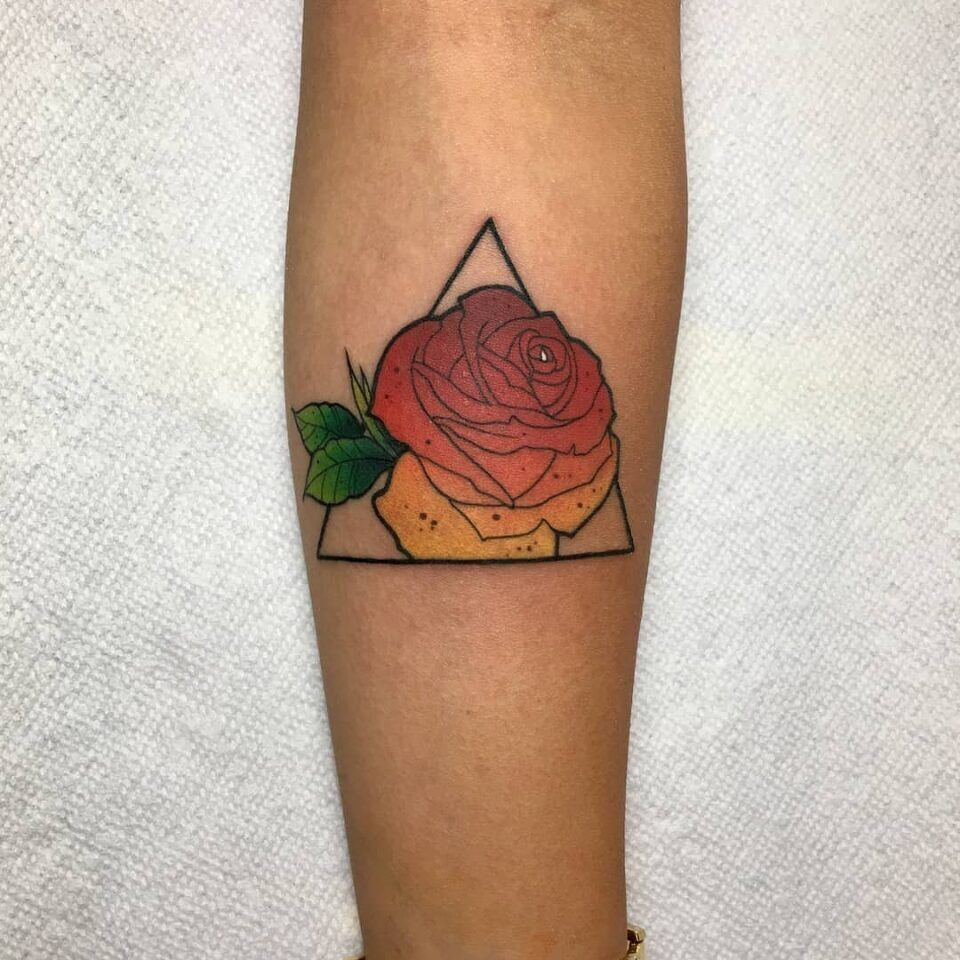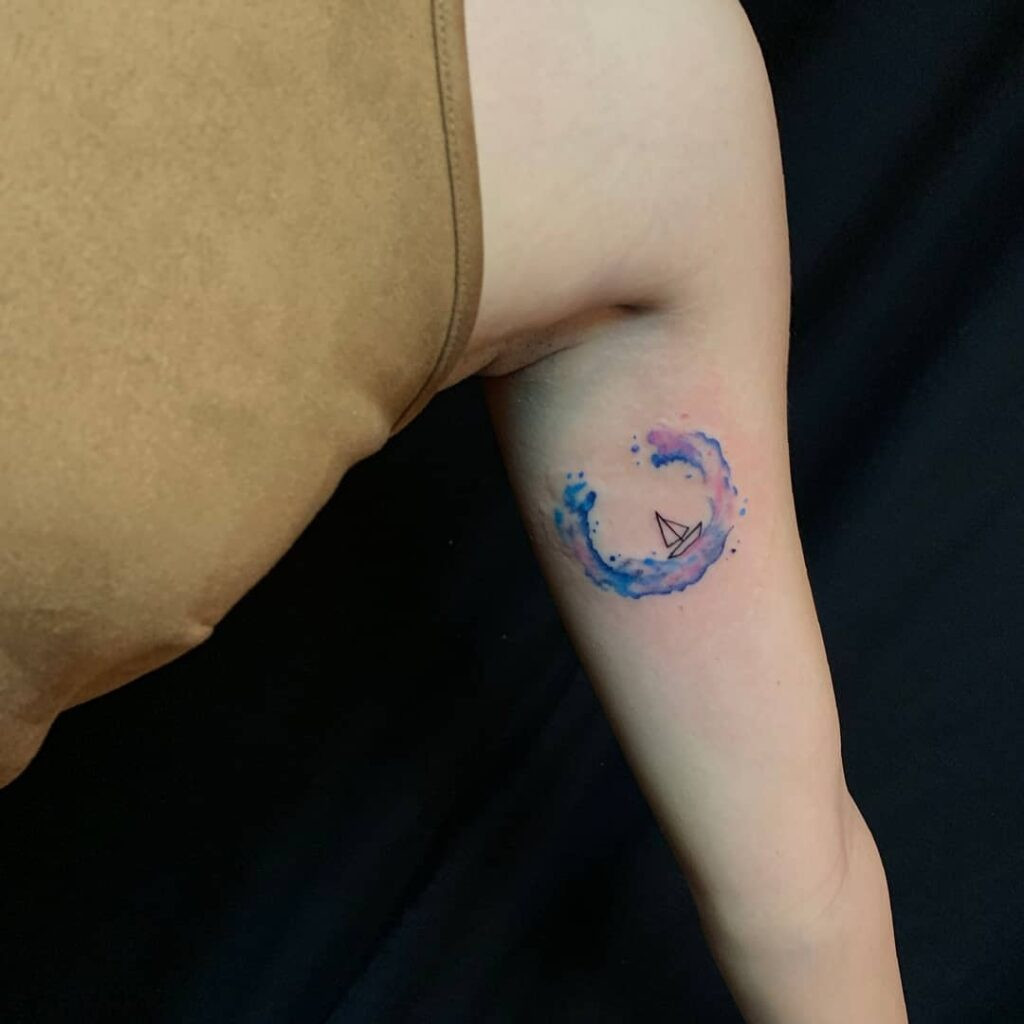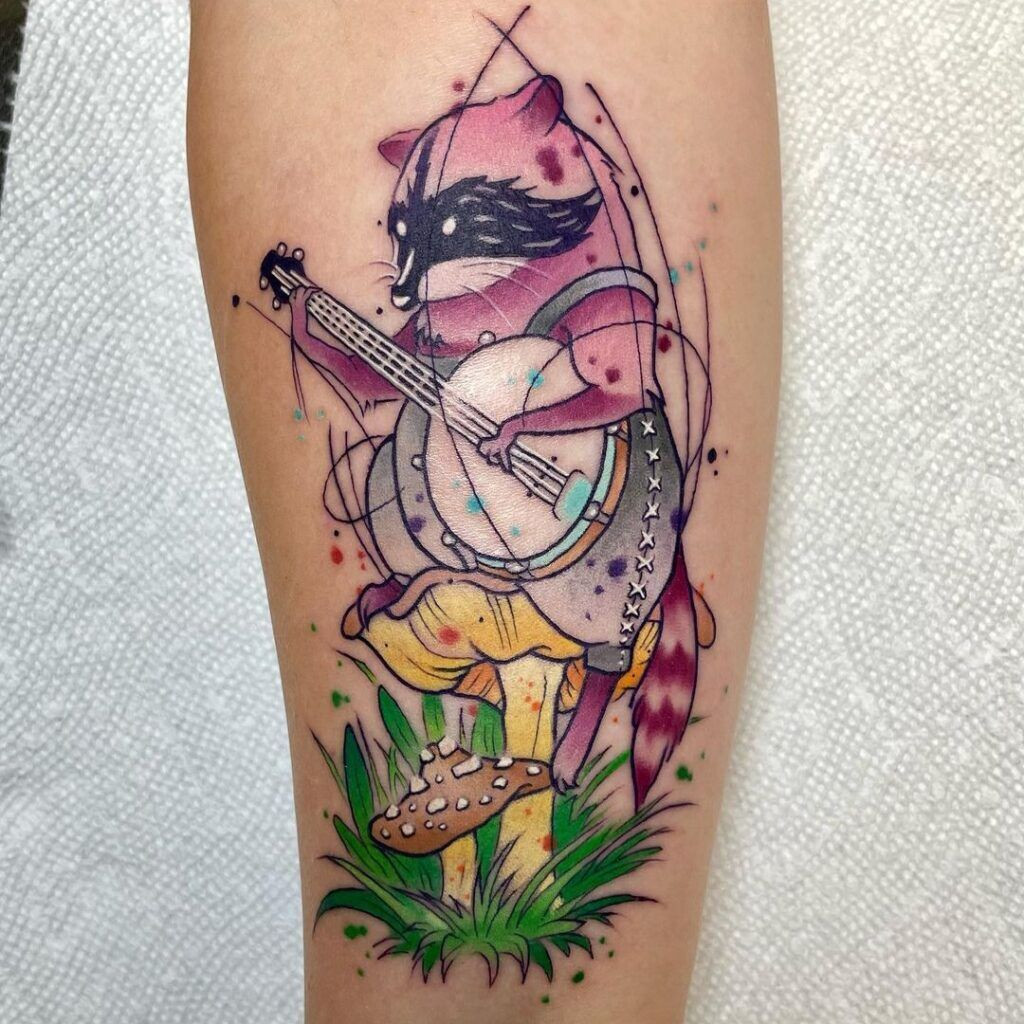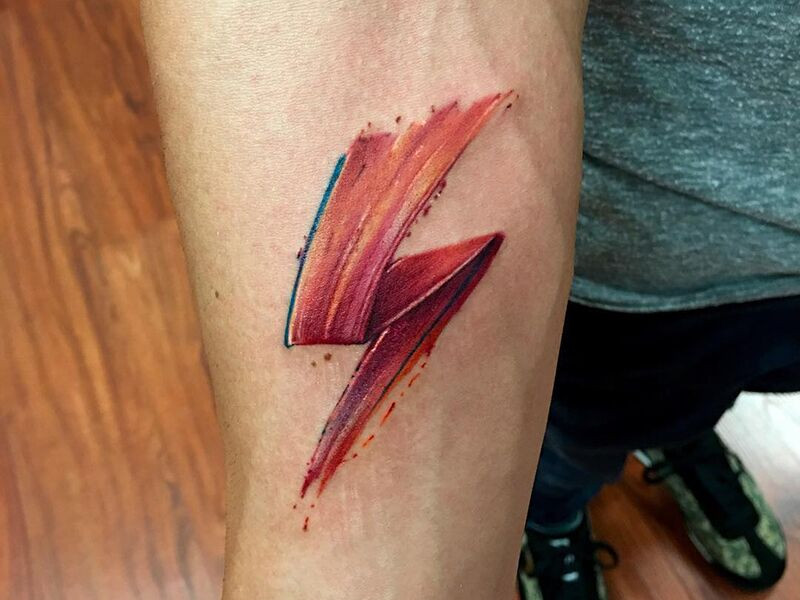Watercolor tattoos bring an artistic and vibrant splash to body art, mimicking the delicate and flowing nature of watercolor paintings. At tattooat.com, we’re passionate about exploring this unique style, offering insights into techniques, designs, and care so you can confidently express your artistic vision. Whether you’re seeking delicate floral designs, abstract landscapes, or simply want to learn about body art, tattooat.com is your ultimate guide.
1. What Are The Hallmarks of the Watercolor Tattoo Style?
Watercolor tattoos distinguish themselves with their vibrant, wash-like colors, mirroring the fluid, transparent layers of traditional watercolor painting. This technique creates an enchanting effect on the skin, transforming it into a living canvas, characterized by fluid designs and soft transitions.
Here’s a detailed look at what makes this style unique:
- Vivid and Vibrant Colors: Watercolor tattoos employ a broad color palette, enabling artists to create stunning gradients and color washes.
- Fluid and Organic Designs: The designs often mimic the spontaneous and free-flowing nature of watercolor painting.
- Blending and Layering Techniques: Artists use these techniques to create seamless color transitions, providing a dreamy, ethereal look.
- Soft Edges and Transitions: Watercolor tattoos often lack bold, definitive outlines, giving them a soft and airy appearance.
- Emphasis on Artistic Expression: This style allows for unique and individualized artwork, reflecting the artist’s creativity.
- Incorporation of Watercolor Painting Aesthetics: The tattoos adopt the fluid, transparent qualities of watercolor paints.
- Creative Use of Negative Space: Leaving certain areas of the skin untouched can emphasize the design and add visual interest.
- Varied Styles and Themes: Watercolor tattoos can range from abstract patterns to detailed depictions of animals and nature.
The lack of bold outlines is a significant characteristic, allowing the ink to spread organically, creating a dreamy, ethereal look, enhancing the tattoo’s artistic appeal.
2. How Do Fluid Designs and Soft Transitions Create Unique Watercolor Tattoo Art?
Fluid designs and soft transitions in watercolor tattoos create unique and personalized artwork by mimicking the natural bleed of watercolors on paper. The seamless transition between colors and the absence of harsh outlines give the design an ethereal quality, making each tattoo a one-of-a-kind masterpiece.
Watercolor tattoos often feature a seamless transition between colors, achieved through color blending, mimicking the natural bleed of watercolors on paper. This technique results in a soft, flowing art piece. Designs often lack harsh outlines, giving them an ethereal quality and contributing to the fluid aesthetic. This characteristic ensures every tattoo is unique, reflecting the wearer’s personality and artistic taste.
The charm of these tattoos lies in their playfulness and spontaneity, reflecting the inherent unpredictability of watercolor painting. Whether you’re considering a bold, vivid masterpiece or a dainty pastel imprint, a watercolor tattoo can be adapted to suit your personal style while retaining the signature elements of soft transitions and fluid lines.
3. What Role Do Blending, Layering, and Negative Space Play in Watercolor Tattoo Composition?
Blending, layering, and negative space are crucial in watercolor tattoos to create depth, dimension, and balance, enhancing the overall visual appeal. These techniques, reminiscent of traditional watercolor painting, transform the skin into a blooming masterpiece.
Layers
Each layer adds depth and dimension, creating an art-filled masterpiece that blooms right on your skin. Subject to the artist’s expertise, the delicate interplay between different ink colors and techniques mimics the gradient and flow of actual watercolors.
The Art of Blending
Mastering the art of blending requires both time and patience. The tattoo needle acts as a painter’s brush, with the strokes applied in different directions and varying degrees of pressure to expertly blend the colors.
Through layering, tattoo artists can achieve intense or muted shades, creating beautiful transitions from one color to the next whether in saturated hues or soft pastels.
Negative Space
Negative space, often overlooked but hugely important, plays a pivotal role in emphasizing the design and providing balance. It can draw attention and add contrast, acting as the blank or untinted portions in a watercolor painting.
Embracing the power of negative space can result in a more dynamic and visually stunning watercolor tattoo, one that catches the eye and holds it engaged.
As an amalgamation of science, creativity, and artistry, the composition of watercolor tattoos is unique to each individual. So, whether it’s an ethereal butterfly fluttering on your wrist or a vibrant cosmos spreading across your back, the blending, layering, and attention to negative space will give you a skilled watercolor tattoo.
4. Why Are Vibrant Colors a Trademark of Watercolor Tattoos?
Vibrant colors are a trademark of watercolor tattoos because they allow artists to create blends and gradients reminiscent of real watercolor artwork, offering a comprehensive spectrum of tones that evoke emotions and capture the eye. The use of gradients creates a dynamic display of shades, resulting in a truly unique piece of wearable art.
 watercolor tattoos
watercolor tattoos
Watercolor tattoo techniques enable artists to create blends and gradients reminiscent of real watercolor artwork. You might find tattoos embodying subtle transitions from hot pink to velvety purple, or a dynamic splash of cerulean blue mixed with vivid greens. These are not mere blocks of color but rather a spectacular display of shades that combine to create a truly unique piece of wearable art.
Creating these bright visuals requires precise skill, as tattooing is not as forgiving as watercolor painting on paper. Artists must carefully plan their color transitions, requiring in-depth knowledge of how different ink colors interact with each other and the impact of skin tone on the result. A watercolor tattoo bursting with vibrant colors is nothing short of a statement piece, but it requires a skilled artist and a solid plan to get the job done. Consider using watercolor as a splash of color in the background of another style of tattoo to enhance the visual aspect of your art.
5. What Are Some Inspiring Ideas for Watercolor Tattoo Designs?
Inspiring ideas for watercolor tattoo designs include floral arrangements, mythical creatures, and celestial themes, all of which showcase the versatility and artistic possibilities of the style. These tattoos evoke emotions and capture the eye with their vibrant color palette and free-flowing designs.
From ethereal dream catchers to vividly detailed animals, the scope of subjects for watercolor tattoos is boundless. And remember, the beauty of getting a watercolor tattoo is the versatility to mix, match, and blend colors in unique ways. Experimenting with hues and gradients can result in designs as distinctive as you are.
For a burst of floral enchantment, consider a garden of pastel-colored flowers as a watercolor tattoo. The soft lines and varying colors emulate the delicate nature of petals while giving a 3D effect of blooming flora on your skin. From cherry blossoms to roses, watercolor tattoos lend a degree of realism to these floral designs that no other tattoo style can match.
If you lean more towards the fantastical, watercolor tattoos can artistically interpret mythical creatures too. Think about a phoenix rising, its fiery features denoted by a swirl of orange, red, and yellow. Or perhaps a mermaid demonstrated through an ethereal mix of ocean blues and pearlescent skin tones.
Artistic interpretations of galaxies, constellations, and outer space visuals can also make for an awe-inspiring watercolor tattoo. There is freedom to play with vibrant blues, purples, and blacks and provide the illusion of a night sky immersed in colors, giving a unique twist to celestial tattoos.
Regardless of what you choose, remember that a watercolor splash can be incorporated with nearly any other designs and styles to give your art a unique edge.
6. How Can You Choose the Perfect Watercolor Tattoo Design?
To choose the perfect watercolor tattoo design, consider your aesthetic preferences, the color palette that resonates with your personality, and the symbolism you want to express through your tattoo. This ensures that your tattoo is not only visually appealing but also personally meaningful.
Aesthetics
You may be drawn to the big, beautiful bursts of color characteristic of watercolor tattoos, small splashes of hues, or softer gradients. Each watercolor tattoo can be a beautiful piece of art on your skin, but knowing what you want from your design, be it an abstract representation or a more literal design, will be key to your satisfaction.
Color Palette
The choice of colors is critical in a watercolor tattoo. While vibrant hues may be appealing, ensure you opt for colors that resonate with your personality long-term. Are you a lover of warm sunsets, the cool ocean, or the magnificent sky? These preferences will define your color palette.
You should also consider what colors make sense artistically with your design and the symbolism of what you’re hoping to achieve if necessary. For example, if you get a tattoo of a fox you may opt for the classic orange color of the animal itself or you may choose to give it splashes of green to express your environmental activism and love for animals.
7. What Does the Creation Process of a Watercolor Tattoo Involve?
The creation process of a watercolor tattoo involves a consultation, design creation, stencil application, and the precise application of vibrant tattoo inks to mimic the subtle diffusion of traditional watercolor art. This requires the artist to have a strong sense of color theory and technique.
The process begins, as most tattoos do, with a consultation with your skilled artist (usually virtual these days). Here, you’ll discuss:
- Design
- Colors
- Size
- Placement
- Any other incorporated styles or elements
- Quoted cost and time
Once the conversation is over, the artist will work on a design for you.
You’ll go in for your appointment and a stencil of the design is created. This stencil serves as a guide for the artist. Armed with an arsenal of vibrant tattoo inks, the artist relies on their sense of color theory, applying hues and shades to mimic the subtle diffusion of traditional watercolor art on your skin.
In a watercolor tattoo, contrasting hues may flow together beautifully without harsh black lines, creating a spectrum of colors that bloom and spread, just as they do on the watercolor artist’s paper. The artist may decide to use a sketchy, broken-black-line technique, hinting at structure while still allowing for a wash of pigments.
What truly sets a watercolor tattoo apart, however, is the deftness and precision required by the artist to create the illusion of actual watercolor paintings. It’s an enchanting dance between needle and skin, a blending of techniques to achieve that evocative, ethereal result that makes watercolor tattoos a unique and stunning option in the world of body art.
8. How Can You Maintain the Vibrancy of Your Watercolor Tattoo?
To maintain the vibrancy of your watercolor tattoo, keep the tattoo clean and dry, gently wash it with mild soap, apply a thin layer of fragrance-free moisturizer, avoid picking or scratching, and protect it from direct sunlight. Proper aftercare ensures your tattoo remains lively and colorful.
Now, your go-to for aftercare questions should always be your tattoo artist. But here are a few important points for the road:
- Keep the tattoo clean and dry for the first 24 hours.
- Wash gently with mild, fragrance-free soap and water, then pat dry with a clean towel you don’t mind ruining with ink.
- Apply a thin layer of fragrance-free moisturizer or tattoo-specific ointment to keep the tattoo hydrated.
- Avoid picking or scratching at the tattoo, as this can cause scarring and affect healing.
- Avoid exposing the tattoo to direct sunlight or ANY bodies of water (baths, too) until it’s fully healed.
- Wear loose, breathable clothing to prevent irritation.
- Follow any additional aftercare instructions provided by your tattoo artist.
9. Are Watercolor Tattoos More Painful Than Other Types of Tattoos?
While pain tolerance varies from person to person, watercolor tattoos are generally not considered more painful than other types of tattoos. The level of pain depends more on the placement of the tattoo and the individual’s pain threshold rather than the style itself.
The location of the tattoo significantly impacts the pain level. Areas with more nerve endings or thinner skin, such as the ribs, ankles, and head, tend to be more sensitive. According to a study by Portland State University’s Art Department in July 2023, artists like Marco Cerretelli use techniques that minimize discomfort, focusing on layering and blending to reduce the time spent on sensitive areas. Personal pain tolerance also plays a crucial role; what one person finds tolerable, another may find quite painful. Proper preparation, such as staying hydrated and avoiding alcohol, can help manage pain levels.
Therefore, while the pain experience is subjective, watercolor tattoos, in general, do not inherently cause more pain than other tattoo styles.
10. How Long Do Watercolor Tattoos Typically Last Compared to Traditional Tattoos?
Watercolor tattoos may fade more quickly than traditional tattoos due to their lighter application and lack of bold outlines. However, with proper care and maintenance, they can still last for many years.
The longevity of a watercolor tattoo depends on several factors:
- Sun Exposure: UV rays can break down the tattoo ink, causing it to fade. Consistent use of sunscreen is essential.
- Skin Hydration: Keeping the skin moisturized helps maintain the vibrancy of the tattoo.
- Placement: Tattoos on areas with high friction or frequent movement may fade faster.
- Artist Technique: Skilled artists use techniques to ensure the ink is properly embedded in the skin, which can extend the tattoo’s lifespan.
A well-maintained watercolor tattoo can last for many years, though it may require occasional touch-ups to keep the colors vibrant. According to Inked Magazine in June 2024, touch-ups can revitalize the tattoo, ensuring it continues to look fresh and appealing.
11. What Aftercare Products Are Best for Watercolor Tattoos?
The best aftercare products for watercolor tattoos include mild, fragrance-free soaps, moisturizers, and tattoo-specific ointments that keep the skin hydrated and promote healing. Avoiding harsh chemicals and fragrances is crucial for preserving the tattoo’s vibrancy.
Here are some recommended aftercare products:
- Fragrance-Free Soap: Use a gentle, unscented soap to clean the tattoo without irritating the skin.
- Tattoo-Specific Ointments: These ointments are designed to promote healing and prevent infection.
- Moisturizers: Apply a thin layer of fragrance-free moisturizer to keep the skin hydrated.
- Sunscreen: Protect the tattoo from UV rays by applying sunscreen regularly, especially during sun exposure.
Proper aftercare is essential for ensuring the longevity and vibrancy of a watercolor tattoo. Following the artist’s instructions and using the right products can help maintain the tattoo’s appearance for years to come.
12. Can Watercolor Tattoos Be Done on All Skin Tones?
Watercolor tattoos can be done on all skin tones, but the vibrancy and visibility of the colors may vary. Lighter skin tones typically allow for brighter and more vivid colors, while darker skin tones may require adjustments in ink selection and technique to ensure the tattoo is visible and retains its artistic quality.
According to a study by Portland State University’s Art Department in August 2023, artists must consider the following factors:
- Ink Selection: Choosing inks with high opacity can help ensure the colors show up well on darker skin tones.
- Layering: Using multiple layers of ink can enhance the visibility of the colors.
- Contrast: Creating contrast between the tattoo and the skin tone can make the design stand out.
While watercolor tattoos can be adapted for all skin tones, it’s essential to consult with an experienced artist who understands how to work with different skin types to achieve the best results.
13. What Are the Risks Associated with Watercolor Tattoos?
The risks associated with watercolor tattoos are similar to those of any tattoo, including infection, allergic reactions, and scarring. Choosing a reputable artist and following proper aftercare procedures can minimize these risks.
Some potential risks include:
- Infection: Improper sterilization of equipment can lead to bacterial infections.
- Allergic Reactions: Some individuals may be allergic to tattoo inks.
- Scarring: Picking or scratching the tattoo can cause scarring.
- Fading: Watercolor tattoos may fade more quickly than traditional tattoos if not properly cared for.
To minimize risks, it’s essential to:
- Choose a Reputable Artist: Ensure the artist is licensed and has a clean, sterile environment.
- Follow Aftercare Instructions: Adhere to the artist’s aftercare guidelines to promote healing and prevent infection.
- Monitor for Allergic Reactions: Watch for signs of an allergic reaction, such as redness, itching, or swelling.
By taking these precautions, you can enjoy your watercolor tattoo while minimizing potential risks.
14. Are There Any Specific Styles That Complement Watercolor Tattoos?
Yes, several styles complement watercolor tattoos, enhancing their visual appeal and creating unique designs. Combining watercolor techniques with other styles can lead to stunning results, adding softness and subtlety to traditionally more defined tattoo styles.
Some complementary styles include:
- Geometric: Incorporating geometric shapes with watercolor elements can create a modern and visually striking design.
- Floral: Combining floral designs with watercolor techniques enhances the delicate and ethereal nature of both styles.
- Abstract: Abstract designs blend seamlessly with watercolor techniques, allowing for creative and unique interpretations.
- Fine Line: Adding fine line details to watercolor tattoos can provide structure and definition while maintaining the soft, flowing aesthetic.
Experimenting with different styles can result in a personalized and visually captivating watercolor tattoo.
15. What Are the Trends in Watercolor Tattoo Art?
Trends in watercolor tattoo art include incorporating vibrant color gradients, minimalist designs, and nature-inspired themes, reflecting a desire for unique and expressive body art. These trends showcase the versatility and artistic potential of watercolor tattoos.
Some current trends include:
- Vibrant Color Gradients: Using a wide range of colors to create seamless transitions and eye-catching designs.
- Minimalist Designs: Opting for simple, understated designs that highlight the beauty of the watercolor technique.
- Nature-Inspired Themes: Incorporating elements such as flowers, animals, and landscapes into watercolor tattoos.
- Abstract Patterns: Creating unique and expressive designs through abstract shapes and patterns.
These trends demonstrate the evolving nature of watercolor tattoo art and the endless possibilities for creative expression.
Discover the world of watercolor tattoos at tattooat.com! Explore diverse designs, find talented artists, and learn essential tattoo knowledge. Start your tattoo journey with us today! Address: 1825 SW Broadway, Portland, OR 97201, United States. Phone: +1 (503) 725-3000. Website: tattooat.com.
 The Honorable Society_west hollywood_watercolor tattoo_sailboat
The Honorable Society_west hollywood_watercolor tattoo_sailboat
 neo traditional racoon tattoo
neo traditional racoon tattoo
 Water Color Tattoo Portfolio
Water Color Tattoo Portfolio
